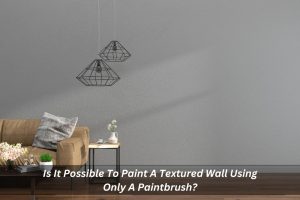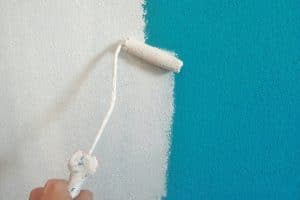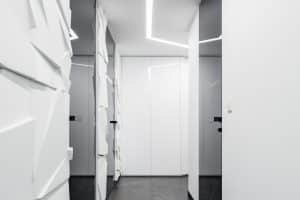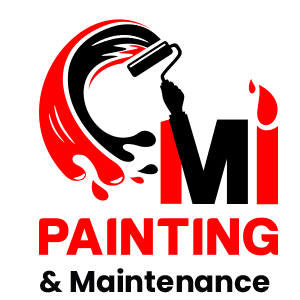Is It Possible To Paint A Textured Wall Using Only A Paintbrush?

Ever considered sprucing up your walls with a fresh coat of paint? While a new layer of colour can work wonders for any room, painting a textured wall can be a bit trickier than smooth surfaces. You might be wondering, can you tackle this project with just a trusty paintbrush? Dive deeper into the world of painting textured walls and see when a brush shines and when it’s best left in the toolbox.
Why might you want to paint a textured wall with a brush?
While rollers dominate the textured wall painting scene, there are situations where a brush swoops in to save the day. Here’s why you might find yourself reaching for a brush instead:
- Conquering corners and curves: Those tricky corners around windows, doors, and light fixtures? They scoff at rollers. A good quality angled brush, with its sharp point, lets you expertly target these tight spaces, ensuring clean lines and even paint application. No more patchy corners or messy edges!
- Taming tiny tasks: Have a small textured wall project, like an accent wall or a feature archway? A roller might feel like wielding a cannon to swat a fly. A brush offers a more manageable approach for these pint-sized jobs. You’ll have more control and precision, applying paint exactly where you want it without wasting time masking off large areas.
- Mastering the details: Adding some artistic flair to your textured walls with stencils or decorative elements? A brush is your best friend for intricate designs. Its finer tip allows for sharper lines and crisper details compared to the broader coverage of a roller. You’ll achieve a professional-looking, handcrafted finish that sets your stylish walls apart.
- Touch-up time: Noticed a minor nick or blemish on your already painted textured wall? Don’t break out the roller for such a small fix. A brush is perfect for these quick touch-up jobs. Just dab a bit of paint to cover the imperfection, and voila! Your wall is back to its flawless glory.
When is a paintbrush not ideal for painting textured walls?
While a paintbrush can be a handy tool for certain situations, it’s not always the most practical choice for painting textured walls. Here’s why:
- Time: Painting an entire textured wall with just a brush is a time-consuming endeavour. The uneven surface requires more strokes and meticulous application to achieve full coverage.
- Coverage: A roller deposits paint much faster and more evenly than a brush. This is especially true for textured surfaces where the brush might struggle to reach all the nooks and crannies.
- Evenness: Achieving a smooth, even finish on a textured wall with just a brush can be difficult. The brush strokes can sometimes show through, especially on finer textures.

How do you achieve the best results when painting textured walls with a brush?
If you’re determined to tackle painting a textured wall with a brush, there are ways to maximise your success:
- Brush selection: Choose a high-quality angled brush with a firm bristle that can hold a good amount of paint. A 2-inch angled brush is a good all-round choice.
- Technique: Don’t just swipe the brush back and forth. Instead, use a stippling motion, gently dabbing the brush into the textured areas to ensure the paint reaches all the grooves. This technique helps to paint without leaving brush marks as much as possible.
- Paint application: Apply the paint in thin layers and allow each layer to dry completely before adding another. This will help prevent paint from building up and obscuring the texture.
What alternatives are there to painting textured walls with just a brush?
While a brush can be useful for touch-ups and detailed areas, for a full painting textured wall project, it’s best to combine it with another tool: the roller.
- Roller for textured walls: Opt for a roller with a thick nap (usually ¾ inch or more) designed for textured surfaces. This type of nap allows the roller to hold more paint and reach deeper into the grooves.
- Combination approach: Use the roller for the main sections of the wall and then follow up with the brush for areas like corners, edges, and around trim. This approach offers the best of both worlds: speed and coverage from the roller, and precision and detail from the brush.
When should you consider hiring a professional to paint textured walls?
Painting textured walls, especially large areas, can be a significant undertaking. Here are some situations where hiring a professional painter might be the better option:
- Large or complex projects: If you’re tackling a large room or a wall with intricate textures, a professional painter can complete the job efficiently and achieve a flawless finish.

- Experience with textured surfaces: Professional painters have the experience and techniques to ensure a smooth, even application on textured walls.
- Desired finish: If you’re looking for a specific finish, like a Venetian plaster effect, hiring a professional with expertise in textured wall painting is recommended.
Conclusion
So, can you paint a textured wall with just a paintbrush? Technically, yes. But for most projects, it’s not the most practical or efficient approach. Combining a brush with a roller specifically designed for textured surfaces is the best way to achieve a professional-looking finish while saving yourself time and frustration. If you’re unsure about your DIY skills or want a guaranteed high-quality result, consider hiring a professional painter experienced in tackling textured walls. With the right tools and approach, you can breathe new life into your textured walls and give your space a whole new look.
Feeling overwhelmed by the textured wall transformation you have in mind? Don’t worry, Mi Painting is here to help! Our experienced team of painters are equipped with the knowledge and tools to tackle any textured wall challenge, big or small. We’ll ensure a flawless finish that complements your unique style.
Contact us today for a free quote and let’s discuss how we can bring your textured wall vision to life!
